Vietnam People's Navy
| Vietnam People's Navy Hải quân Nhân dân Việt Nam | |
|---|---|
 | |
| Active | 1955 – present |
| Country |
|
| Allegiance |
|
| Branch |
Main branches
|
| Size |
50,000 officers and sailors 91 Ships (Excluding auxiliaries) |
| Part of |
|
| Headquarters | Hai Phong, Vietnam |
| Motto(s) | Island is home, Sea is country |
| Colour | Purple, White |
| March | Surfing to the sea |
| Anniversaries | 7 May 1955 |
| Fleet |
5 Submarine 7 Frigate 11 Corvette 53 Patrol vessel 6 Amphibious warfare ship 8 Minesweeper 1 Training vessel 11 Auxiliaries |
| Engagements |
World War II Vietnam War Cambodian–Vietnamese War Johnson South Reef Skirmish MT Zafirah hijacking |
| Decorations |
|
| Commanders | |
| Commander-in-Chief | Trần Đại Quang |
| Commander | Rear Admiral Phạm Hoài Nam |
| Political Commissar | Vice Admiral Đinh Gia Thật |
| Chief of Staff | Rear Admiral Phạm Xuân Điệp |
| Insignia | |
| Naval Ensign |
 |
| Naval Flag |
 |
| Emblem |
 |
| Awards |
|
| Aircraft flown | |
| Attack | Ka-27 |
| Patrol | C-212, DHC-6, EC225 |
The Vietnam People's Navy (Vietnamese: Hải quân nhân dân Việt Nam), commonly known as the Vietnamese Navy or the Vietnamese People's Navy, is the naval branch of the Vietnam People's Army and is responsible for the protection of the country's national waters, islands, and interests of the maritime economy, as well as for the co-ordination of maritime police, customs service and the border defence force.
History
Early period
From the beginning of the founding of the Vietnamese Nation in the 1st millennium BC, the Hùng Vuong period spawned many legends of fighting against seaborne invasions of Quynh Chau (now China) from the north and Ho Ton (later to become Champa) from the south. During the era of the Kingdom of Âu Lạc, when the Cổ Loa Citadel was constructed, King An Dương Vương relied on the Hoang Giang River as a natural fortification to protect the south flank of the cidatel. In the 6th century, Emperor Lý Nam Đế built naval forces to fend off the invasion of Liang Dynasty's (China) forces in the Tô Lịch River, Dien Triet lake; and then, King Triệu Quang Phục used guerrilla tactics against the Chinese military at Da Trach lagoon (Khoái Châu, Hải Dương).[2]
In the 10th century, the Imperial Vietnamese Navy became a regularised force. Naval forces of Khúc Thừa Dụ in Hong Chau (now Ninh Giang District, Hải Dương), Dương Đình Nghệ in Ai Chau, Thanh Hóa and of King Ngô Quyền himself were raised by enlisting and training the fishermen along rivers and seasides. Those elements became well-trained and experienced naval forces, ready to protect the country.
Dynastic period
In Lý–Trần Dynasty era, the dynasties were occupied with raising naval forces and naval bases. Particularly, the Vân Đồn port had an important role in protecting the northeast territorial waters of Vietnam. In 1075 Lý Thường Kiệt mobilised a fleet to ferry 50,000 marines across the Gulf of Tonkin to invade Qinzhou, China. The amphibious assault was well planned and executed with incredible speed that Qinzhou's garrison was totally taken by surprise. The fortress town was taken in one night.
To retaliate, the Song dynasty of China mustered a huge invasion force, with a naval arm to provide support to land operations. They were already fearful of Vietnam's reputation at sea combat, thus a large enough force was organised so as to "not lose even if they can't score a win". Lý Kế Nguyên, a Vietnamese commander stationed in Vân Đồn, Quảng Ninh, however, had absolute confidence in his fleet that he went on the offensive and took on the Chinese invasion fleet on the high sea. Lý defeated the Chinese so badly that their admiral sent messengers to urge Chinese coastal guards to fortify their post in fear of a reverse-invasion.
In 1077, the Imperial Vietnamese Navy fought the Battle of Cầu River against the Chinese Song Dynasty forces. This was the final battle Song Dynasty would fight on Vietnamese land or waters. The battle lasted for several months, and ended with the victory of the Vietnamese Navy and the loss of many Song sailors. This victory demonstrated the successful tactics of war and active defence of the famous Admiral Lý Thường Kiệt who faced a naval force numerically superior to his own.[3] The Song Dynasty lost a total of 8,000 soldiers/sailors and 5.19 million ounces of silver, including all costs of the war.[4]
The largest battles (officially recorded in history) were three naval encounters (all three are called Battle of Bạch Đằng): Admiral, later Emperor Ngô Quyền against the Chinese Southern Han forces in 938 (killed over 10,000 and captured hundreds of Chinese sailors, killed Chinese Prince Liu Hongcao); Lê Hoàn against Song Dynasty in 981; and Trần Quốc Tuấn against Yuan Dynasty (Mongol) in 1288 (over 80,000 Yuan Mongol sailors killed or captured, more than 400 Yuan (Mongol) ships destroyed, Mongol Commander Sogetu perished, and Yuan (Mongol) Admiral Omar captured).
The Đại Việt sử ký toàn thư records that in 1467 in An Bang province of Đại Việt (now Quảng Ninh Province) a Chinese ship blew off course onto the shore. The Chinese were detained and not allowed to return to China as ordered by Emperor Lê Thánh Tông.[5][6][7][8][9] This incident may be the same one where Wu Rui was captured.[10] One of the renowned victories in Vietnamese naval history was the Battle of Rạch Gầm-Xoài Mút in Tây Sơn Dynasty, during which Nguyễn Huệ (Emperor Quang Trung) defeated the Siamese (Thai) naval force. The battle occurred in present-day Tiền Giang Province on 19 January 1785. Nguyễn Huệ's forces completely destroyed over 50,000 Siamese sailors and 300 warships.
In the Nguyễn Dynasty period, 19th century Nguyen Emperor Gia Long used his new base to improve the Vietnamese Navy. Gia Long had first attempted to acquire modern naval vessels in 1781, when on the advice of Bishop Pigneau de Behaine, he had chartered Portuguese vessels of European design, complete with crew and artillery. This initial experience proved to be disastrous. For reasons that remain unclear, two of the vessels fled in the midst of battle against the Tây Sơn, while angry Vietnamese soldiers killed the third crew.
In 1789, Pigneau de Behaine returned to Vietnam from Pondicherry with two vessels, which stayed in the Nguyễn Dynasty service long-term. Over time, Vietnamese sailors replaced the original French and Indian crew under the command of French officers. These vessels became the foundation for an expanded military and merchant Nguyễn Dynasty naval force, with Gia Long chartering and purchasing more European vessels to reinforce Vietnamese-built ships. However, traditional Vietnamese-style galleys and small sailing ships remained the majority of the fleet. In 1799, a British trader by the name of Berry reported that the Nguyễn Dynasty's fleet had departed Saigon along the Saigon River with 100 galleys, 40 junks, 200 smaller boats and 800 carriers, accompanied by three European sloops. In 1801, one naval division was reported to have included nine European vessels armed with 60 guns, five vessels with 50 guns, 40 with 16 guns, 100 junks, 119 galleys and 365 smaller boats.[11]
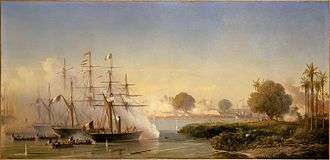
In the middle of the 19th century, the Vietnamese Navy fought against the French in many battles. Due to disadvantages in technology, the Vietnamese Navy could not defeat the French Navy, but there were still several battles during which the Vietnamese Navy caused heavy damages to the French. The Vietnamese were especially successful in the Battle of Nhat Tao canal held by Nguyễn Trung Trực on 10 December 1861. Nguyen Trung Truc's naval forces ambushed the French brig L'Esperance at the Vam Co River, Mekong Delta. Truc's 150 men were grouped into three columns. The first group of 61 sailors under Hoang Khac Nhuong was to attack a nearby pro-French village to provoke an incident and lure the French forces into an ambush. Truc commanded the second group of 59 partisans along with Vo Van Quang, and was assigned to burn and sink the vessel. A third force of 30 sailors was commanded by Ho Quang and Nguyen Van Hoc. Due to the surprise attack, the French Navy suffered major damage: the brig L'Esperance was sunk, 17 French sailors and 20 pro-French Vietnamese naval auxiliaries were killed, only eight people escaped, including two French sailors and six sailors of Tagal (Filipino) background employed by the French.
Vietnam War
.jpg)
On 19 July 1946, Acting President of Democratic Republic of Vietnam Huỳnh Thúc Kháng signed into law a decree establishing the modern Vietnamese Navy. Then, on 10 September of that year, General Võ Nguyên Giáp started to build a flotilla as the core of the new navy. On 8 March 1949, Vietnam established the Department of Naval Research under the General Staff. This department has performed both research and training to prepare for combat missions.
Following the Geneva Conference in 1954, the Democratic Republic of Vietnam went about creating its own naval forces. On 7 May 1955 the Vietnam People's Navy was created with the establishment of the General Directorate of Coastal Defence, it formed the basis for the Navy Operational Command (based on the Vietnamese Ministry of Defence decree No. 284/ND signed by General Võ Nguyên Giáp to established Naval Research Board, under the General Staff, on 8 March 1949). The primary mission of the Navy was to patrol the coastal areas and the inland waterways.
Throughout the Vietnam War the role played by the Vietnam People's Navy (or North Vietnamese Navy) was largely unknown to the public. However, on 2 August 1964, three North Vietnamese Swatow-class patrol boats attacked the destroyer USS Maddox in what became known as the Gulf of Tonkin Incident. The second attack, which the United States claimed to have occurred on 4 August, was dismissed by the North Vietnamese as a fabrication.
The North Vietnamese, however, had maintained their own version of the events which took place. According to official VPN accounts Maddox penetrated North Vietnamese waters on 31 July 1964, and provoked a battle with the North Vietnamese. In response to American provocation, three 123K-class torpedo boats from the 135th Torpedo Boat Battalion were dispatched to intercept the American destroyer. The resulting clash became known as the 'Battle of Thanh Hóa' in which North Vietnamese "torpedo boats succeeded in driving the Maddox out of Vietnam's territorial waters, shooting down a U.S. aircraft and damaging another".
Apart from patrolling territorial waters, the Navy also had the mission of transporting military supplies to support the Vietnam People's Army and their NLF ally during the Vietnam War. On 31 October 1961, a sea route version of the Ho Chi Minh trail was established by the North Vietnam Navy, with the 759th Transport Unit responsible for carrying military supplies and other goods for the Communist ground forces in South Vietnam. To avoid detection by the South Vietnamese and U.S navies, North Vietnamese transport ships were often disguised as fishing trawlers. On 16 February 1965, a 100-ton North Vietnamese trawler from the Transportation Group 125 was discovered at Vung Ro Bay. This led to the creation of Operation Market Time by the US Navy to intercept disguised enemy ships.
On 19 April 1972, the North Vietnamese Navy and Air Force participated in the Battle of Đồng Hới off the coast of North Vietnam. During this battle it was believed that the U.S Navy destroyed a Soviet-made cruise missile for the first time. The destroyer USS Higbee was damaged after an VPAF MiG-17 dropped a 250 lb (110 kg) bomb, destroying a 5-inch (127 mm) aft gun mount.
In the years following the complete withdrawal of U.S and other allied forces, the North Vietnamese went back on the offensive. As part of the Ho Chi Minh Campaign, the North Vietnamese Navy increased the transportation of military supplies, food and uniform to the Communist forces in the South. When the North Vietnamese Army (NVA) occupied the northern provinces of South Vietnam in 1975, captured South Vietnamese vessels were pressed into service with the Vietnam People's Navy. In April 1975, ex-South Vietnamese Navy vessels carried North Vietnamese troops to capture the Spratly Islands. Opening battle in the island Southwest Cay (Vietnamese: Song Tử tây) on 4 April 1975, amphibious raid by sea of the Naval Marine corp number 1 (precursor of the 126th Brigade Naval Marine corps) and three vessels of the 125 corps coordinated with the commandos of the 5th Military Region, after 30 minutes, Vietnamese Navy controlled the main battle area, facilitating the solution development process release of the other islands.[12] Then, Vietnamese Navy continue control Sand Cay island (26 April), Namyit Island (27 April), Sin Cowe Island (28 April) and Spratly Island (29 April).[13] At around the same time the Chinese Navy took over control of the Paracel Islands from the South Vietnamese Navy. These islands are also claimed by Vietnam, however they have no current presence there.
Prior to 1975, the North Vietnamese Navy operated fewer than forty patrol boats along with the coastal junk force. With the collapse of the Republic of Vietnam on 30 April 1975, the Vietnam People's Navy was expanded with ships from the defunct South Vietnamese Navy. Captured vessels included two patrol frigates, over one hundred patrol craft, and about fifty amphibious warfare ships.
In the late 1970s the naval infantry (or marines) was formed to be stationed on the areas claimed by the Socialist Republic of Vietnam in the Spratly Islands. The naval infantry is equipped with PT-76 light tanks, BTR-60 personnel carriers and naval infantrymen are armed with AK-74 rifle, AKM-47 assault rifles, Makarov PM pistol (Officers), and PKM machinegun infantry weapons, and more.
In 1988, Vietnam People's Navy fought against the Chinese Navy at Johnson Reef of sovereignty of the Spratly Islands, causing the losses to the Vietnamese of several transport ships and up to 64 deaths. The battle was won by the Chinese Navy who outgunned and outnumbered them, using a fleet of frigates against Vietnamese lightly armed transport ships. This prompted the Vietnamese Navy to modernise its naval weapons and its overall naval capabilities.
Organisational structure

Organisational levels of Vietnam People's Navy, from highest to lowest are:
- High Command of Vietnam People's Navy (Bộ Tư lệnh Hải quân)
- Naval Region (Vùng Hải quân)
- Naval Brigade/Naval Regiment (Lữ đoàn/Trung đoàn Hải quân)
- Naval Battalion (Hải đoàn)
- Naval Group (Hải đội)
Naval Regions
Naval Regions are inter-military campaign of naval tactics, territorial division, comprising the regions, fleets, naval air forces, marines, defence island soldiers, coastal artillery and combat units to ensure (radar, information technology, logistics etc.).
On 26 October 1975, the Ministry of Defence issued Decision No.141/QD-QP which established five Coastal Areas of Naval Command and jurisdiction provisions of the five regions. In 1978, they were renamed as the following naval regions:
- 1st Regional Command (A Regional Command): Gulf of Tonkin, manage north coast from Quảng Ninh to Hà Tĩnh and the islands in Gulf of Tonkin. Command Headquarters: Hai Phong.
- Commander: Rear Admiral Phạm Văn Điển
- Political Commissar: Rear Admiral Phạm Văn Vững
- 2nd Regional Command (B Regional Command): manage South China Sea and south coast from Bình Thuận to Bạc Liêu, southern continental shelf, including the key areas are economic science service areas (called are DK1, DK2). Command Headquarters: Nhơn Trạch, Đồng Nai.
- Commander: Rear Admiral Phạm Xuân Điệp
- Political Commissar: Rear Admiral Mai Tiến Tuyên
- 3rd Regional Command (C Regional Command): manage north central coast, from Quảng Bình to Bình Định, including the islands of Cồn Cỏ, Lý Sơn,...and Paracel Islands. Command Headquarters: Da Nang.
- Commander: Rear Admiral Ngô Sĩ Quyết
- Political Commissar: Rear Admiral Nguyễn Tiến Dũng
- 4th Regional Command (D Regional Command): manage South China Sea, south central coast including Spratly Islands, Phú Quý island and the south central coast, from Phú Yên to Bình Thuận. Headquarters Command: Cam Ranh Bay military port, Khánh Hòa Province.
- Commander: Rear Admiral Phạm Văn Hoành
- Political Commissar: Rear Admiral Phạm Thanh Hóa
- 5th Regional Command (E Regional Command): manage South China Sea and coast in Gulf of Thailand from Cà Mau to Kiên Giang. Command Headquarters: Phú Quốc, Kiên Giang.
- Commander: Rear Admiral Doãn Văn Sở
- Political Commissar: Rear Admiral Ngô Văn Phát
Service branches
| Surface Ships | Naval Commando | Naval Infantry | Naval Aviation | Coastal Defence Missiles | Submarines |
|---|---|---|---|---|---|
 |
 |
 |
 |
 |
Ranks in Vietnam People's Navy
| |||||||||||||||||||||
In the Vietnam People's Navy system has no ranks of Fleet Admiral. Vietnam People's Navy ranks are divided into four basic steps: Commissioned Officer, Non-commissioned Officer, and Soldiers/Seamen. Officer ranks use the executive curl on the sleeves of their service and full dress blue uniforms, similar to those used in various navies worldwide.
| Flag Officers | Senior Officers | Junior Officers | |||||||||
|---|---|---|---|---|---|---|---|---|---|---|---|
| |
|
|
|
|
|
|
|
|
|
| |
| | | | | | | | | | | | |
| | | | | | | | | | | ||
| Đô đốc | Phó Đô đốc | Chuẩn Đô đốc | Đại tá | Thượng tá | Trung tá | Thiếu tá | Đại úy | Thượng úy | Trung úy | Thiếu úy | |
| Admiral | Vice Admiral | Rear Admiral | Commodore | Captain | Commander | Lt.Commander | Senior Lieutenant | Lieutenant | Sub-lieutenant | Ensign | |
| Naval cadet | NCOs | Seamen | ||||
|---|---|---|---|---|---|---|
| |
|
|
|
|
| |
| Học viên Sĩ quan | Thượng sĩ | Trung sĩ | Hạ sĩ | Binh nhất | Binh nhì | |
| Midshipman | Sergeant Major | Master Chief Petty Officer | Chief Petty Officer | Leading Seaman | Seaman | |
Naval Academy

Vietnam Naval Academy, with its headquarters in Nha Trang, is a military institute belongs to Vietnam People's Navy for training naval commanding officers in division level and commanding staffs in tactical/campaign level, include undergraduates and postgraduates of military.
The forerunner of Vietnam Naval Academy is Coastal Training School, was established on 26 April 1955 by the General Staff. The school has changed name in several times such as the Naval Training School in 1959, the Naval School of Vietnam in 1961, the Naval Officers School in 1967, School of Commander Naval engineering in 1980. Finally, the school has named Naval Academy in 1993.
After 55 years of construction, combat and growth, Vietnam Naval Academy has trained thousands of officers and technical staffs for major specialised fields such as: control vessel; mines - anti-mine; missile anti-submarine; gunship; information; radar - sonar; coastal radar; ship factory and power; the commander of the Marine Police and Border Defence Force.
In addition, the Vietnam Naval Academy has trained officers for both the Royal Cambodian Navy and the Lao People's Navy.
Fleet
| Submarines (5 in Service) | ||||||
|---|---|---|---|---|---|---|
| Photo | Class | Origin | Type | Quantity | Notes | Ships |
 |
Improved Kilo class | |
Submarine | 5 | (1) more under construction | 182 Hà Nội 183 Hồ Chí Minh City 184 Hải Phòng 185 Khánh Hoà 186 Đà Nẵng[14] 187 Bà Riạ-Vũng Tàu[15] |
| Frigates (7 in Service) | ||||||
| Photo | Class | Origin | Type | Quantity | Notes | Ships |
 |
Gepard 3.9 class | |
Frigate | 2 | 2 delivered, 2 under construction and there are 2 more planned.[16][17] | 011 Đinh Tiên Hoàng 012 Lý Thái Tổ |
.jpg) |
Petya class | |
Frigate | 5 | active duty. 3 are ASW and 2 were converted to gunboats[18] | HQ-09 HQ-11 HQ-13 HQ-15 HQ-17 |
| Corvettes (11 in Service) | ||||||
| Photo | Class | Origin | Type | Quantity | In service | Ships |
 |
Tarantul-I class | |
Corvette | 4[19][20] | active duty[21] | 371 372 373 374 |
| |
Molniya class | |
Corvette | 6[22][23] | (2) more on order. 4 more are planned.[23][24] active duty |
375 376 377 378 379 380 |
 |
BPS-500 | |
ASW Corvette | 1 | active duty | HQ-381 |
| Patrol vessels (23 in Service) | ||||||
| Photo | Class | Origin | Type | Quantity | In service | Ships |
 |
Osa class | |
Missile boat | 8 | active duty | HQ-354, HQ-355, HQ-356, HQ-357, HQ-358, HQ-359, HQ-360, HQ-361 |
 |
Svetlyak class | |
Patrol | 6 | active duty | HQ-261 HQ-263 HQ-264 HQ-265 HQ-266 HQ-267 |
 |
Turya class | |
Patrol | 5 | active duty | HQ-331 HQ-332 HQ-333 HQ-334 HQ-335 |
| TT-400TP class | |
Patrol | 4 | active duty, 2 on order | HQ-272 HQ-273 HQ-274 HQ-275[25] | |
| Minesweepers (8 in Service) | ||||||
| Photo | Class | Origin | Type | Quantity | In service | Ships |
 |
Sonya class | |
minesweeper | 4 | active duty | HQ-861 HQ-862 HQ-863 HQ-864 |
| |
Yurka class | |
minesweeper | 2 | active duty | HQ-851 HQ-852 |
| Yevgenya class | |
minesweeper | 2 | active duty | ||
| Transport/Logistics support ship (11 in Service) | ||||||
| Photo | Class | Origin | Type | Quantity | In service | Ships |
| HSV-6613 class | |
Ocean surveillance | 1 | active duty | HQ-888 Trần Đại Nghĩa | |
| K-122 class | |
Transport/ Logistics support ship |
2 | active duty | HQ-571 Trường Sa HQ-561 Khánh Hòa (Hospital ship) | |
| HQ-996 class | |
Transport/ Logistics |
1 | active duty | HQ-996 | |
| Trường Sa class | |
Transport/ Logistics support ship |
7 | active duty | Trường Sa 04, Trường Sa 08, Trường Sa 14, Trường Sa 19, Trường Sa 20, Trường Sa 21, Trường Sa 22 | |
| Amphibious warfare (5 in Service) | ||||||
| Photo | Class | Origin | Type | Quantity | In service | Notes |
| LST-542 class | Amphibious warfare | 1 | active duty | HQ-501 Trần Khánh Dư (formerly USS Maricopa County, LST-938) | ||
| Polnochny class | |
Amphibious warfare | 3 | active duty | HQ-511 HQ-512 HQ-513 | |
| Hùng Vương class | |
Amphibious warfare | 2 | active duty | HQ-521 HQ-522 | |
| Training vessel | ||||||
| Photo | Class | Origin | Type | Quantity | Notes | Ships |
| |
Training vessel | 1 | on order | HQ-Lê Quý Đôn | ||
| Aircraft (22 in Service) | ||||||
| Photo | Aircraft | Origin | Type | Quantity | In service | Notes |
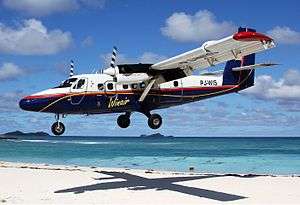 |
DHC-6 Twin Otter | |
Patrol | 6 | active duty | |
| |
Kamov Ka-28 | Kamov |
ASW Helicopter | 8[26] | active duty | to serve in frigates and patrol around Spratly Islands[27][28][29] |
| |
Eurocopter EC225 Super Puma | |
Patrol | 2 | active duty | |
 |
Eurocopter Dauphin | |
ASW Helicopter | 6 | active duty | |
| Magic Eye 01 | |
UAV | under development | |||
| Anti-ship missile/Coastal Defence Missile | ||||||
| Photo | Missile | Origin | Type | Quantity | In service | Notes |
 |
P-800 Oniks (SS-N-26 Yakhont) |
Coastal defence | 10 launcher/ 40 missiles |
2 K-300P Bastion-P systems in active[30] | finished negotiation, technological transferring has already started | |
| P-5 Pyatyorka (SS-N-3 Shaddock) |
Coastal defence | Active duty | Already self-produced by Vietnam | |||
 |
P-15 Termit (SS-N-2 Styx) |
Anti-ship missile/ Coastal defence |
20[20] | active duty/equipped in Tarantul class ships | Replacing by Kh-35 | |
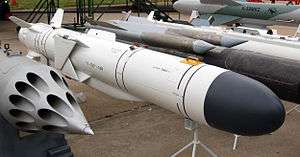 |
Kh-35 Uran-E (SS-N-25 Switchblade) |
Anti-ship missile | 103 missiles[20] 300 more on order |
active duty/equipped in Molniya and Gepard class ships | already self-produced by Vietnam[31] | |
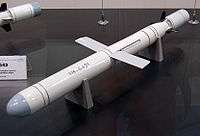 |
3M-54 Klub (SS-N-27 Sizzler) |
Anti-ship missile | 10 missiles (2012) 40 on order[32] |
equipped in Kilo submarines | ||
Inshore Patrol:
-
 Vietnam 10 (+25) HQ-56 class (Stolkraft; 22.5 meter) PB with 1x20mm
Vietnam 10 (+25) HQ-56 class (Stolkraft; 22.5 meter) PB with 1x20mm -
 Vietnam 5 HQ-37 class
Vietnam 5 HQ-37 class -
 USSR 15 Zhuk class patrol boats (Project 1400M)
USSR 15 Zhuk class patrol boats (Project 1400M)
Auxiliaries:
-
 USSR 1 Sorum class logistics tug (Project 745) ATA
USSR 1 Sorum class logistics tug (Project 745) ATA -
 USSR 1 Voda (MTV-6/Project 561) AWT
USSR 1 Voda (MTV-6/Project 561) AWT -
 USSR 5 Nyrat-2 (Project 376U) diving tenders (YDT)
USSR 5 Nyrat-2 (Project 376U) diving tenders (YDT) -
 Vietnam 5 floating drydocks (YFDL)
Vietnam 5 floating drydocks (YFDL) -
 USSR 5 PO-2 (Project 376) YFL
USSR 5 PO-2 (Project 376) YFL -
 United States 5 ex-US 55-meter harbour tankers (YO) - likely ex-USN YOG-5 Class Gasoline Oiler/Barge
United States 5 ex-US 55-meter harbour tankers (YO) - likely ex-USN YOG-5 Class Gasoline Oiler/Barge -
 United States 5 Chaolocco tugs (YTM)
United States 5 Chaolocco tugs (YTM) -
 United States 10 (estimated) harbour tubs (YTL) - likely ex-USN c. 1944-45 and transferred to Republic of Vietnam Navy 1969-1972
United States 10 (estimated) harbour tubs (YTL) - likely ex-USN c. 1944-45 and transferred to Republic of Vietnam Navy 1969-1972
Small Arms
-
 USSR AK-74 Standard Issue Assault rifle.
USSR AK-74 Standard Issue Assault rifle. -
 USSR AKM-47 Standard Issue Assault Rifle being supplemented by AK-74.
USSR AKM-47 Standard Issue Assault Rifle being supplemented by AK-74. -
 USSR PKM machinegun
USSR PKM machinegun -
 USSR Makarov PM Standard issue pistol for all Vietnamese Military services.
USSR Makarov PM Standard issue pistol for all Vietnamese Military services. -
 Israel IMI Tavor TAR-21 Marines and Special Forces Only.
Israel IMI Tavor TAR-21 Marines and Special Forces Only. -
 Israel Uzi Submachinegun Marines and Special Forces Only.
Israel Uzi Submachinegun Marines and Special Forces Only. -
 Israel IMI Negev Light Machine Gun Marines and Special Forces Only.
Israel IMI Negev Light Machine Gun Marines and Special Forces Only.
Manpower
The current total manpower of the navy is around 50,000 officers and enlisted personnel including naval infantry [i.e. marines] and other specialised units.
See also
References
- ↑ "Oath of Honor". 1970. Retrieved 31 October 2015.
To sacrifice himself undeservedly for the fatherland, fight for the cause of national independence and socialism, under the leadership of the Vietnam Workers Party...
- ↑ "Truyền thống quân thủy của cha ông trong lịch sử dân tộc - Quân chủng Hải quân". Qdnd.vn. 15 October 2009. Retrieved 21 May 2013.
- ↑ Phan Huy Lê, Bùi Đăng Dũng, Phan Đại Doãn, Phạm Thị Tâm, Trần Bá Chí 1998, pp. 69–71
- ↑ Phan Huy Lê, Bùi Đăng Dũng, Phan Đại Doãn, Phạm Thị Tâm, Trần Bá Chí 1998, pp. 72–75
- ↑ Cooke (2011), p. 108 The Tongking Gulf Through History, p. 108, at Google Books
- ↑ PGS.TSKH Nguyễn Hải Kế (Associate Professor Dr. Nguyen Hai Ke) (28 March 2013). "CÓ MỘT VÂN ĐỒN Ở GIỮA YÊN BANG, YÊN QUẢNG KHÔNG TĨNH LẶNG". 广州日报大洋网(http://www.dayoo.com). Retrieved 26 July 2013.
- ↑ PGS.TSKH Nguyễn Hải Kế (Associate Professor Dr. Nguyen Hai Ke) (22 April 2013). "CÓ MỘT VÂN ĐỒN Ở GIỮA YÊN BANG, YÊN QUẢNG KHÔNG TĨNH LẶNG". 广州日报大洋网(http://www.dayoo.com). Retrieved 26 July 2013.
- ↑ Lê Văn Hưu, Phan Phu Tiên, Ngô Sĩ Liên... soạn thảo (1272–1697)., eds. (1993). "Đại Việt Sử Ký Toàn Thư (Chapter: Phần 26 (Bản kỷ thực lục Q2(a) Nhà Hậu Lê (1460–1472).)". Viện Khoa Học Xã Hội Việt Nam dịch (1985–1992). Nhà xuất bản Khoa Học Xã Hội (Hà Nội) ấn hành (1993). Retrieved 26 July 2013.
- ↑ Lê Văn Hưu, Phan Phu Tiên, Ngô Sĩ Liên... soạn thảo (1272–1697)., eds. (1993). "Đại Việt Sử Ký Toàn Thư (Chapter: DVSK Bản Kỷ Thực Lục 12: Nhà Hậu Lê (1460–1472) ... Phần 1(Đại Việt Sử Ký Bản Kỷ Thực Lục Quyển XII [1a] Kỷ Nhà Lê Thánh Tông Thuần Hoàng Đế))". Viện Khoa Học Xã Hội Việt Nam dịch (1985–1992). Nhà xuất bản Khoa Học Xã Hội (Hà Nội) ấn hành (1993). Retrieved 26 July 2013.
- ↑ Cooke (2011), p. 109 The Tongking Gulf Through History, p. 109, at Google Books
- ↑ "Bí mật hải quân nhà Nguyễn - Kỳ 1: Từ thủy quân đến hải quân | Thanh Niên Online". Thanhnien.com.vn. 19 September 2011. Retrieved 21 May 2013.
- ↑ Archived 30 April 2012 at the Wayback Machine.
- ↑ "Kỳ 1 : Thần tốc giải phóng Trường Sa - Tiền Phong Online". Tienphong.vn. Retrieved 21 May 2013.
- ↑ "Fifth Vietnamese Kilo Submarine has Completed the First Sea Trials". 22 August 2015.
- ↑ "Russia Launched Last Kilo Submarines for Vietnam". 29 September 2015.
- ↑ "cogitASIA". Retrieved 4 July 2015.
- ↑ tuoitrenews.vn/politics/28254/vietnam-to-receive-two-more-gepardclass-warships-soon-govt-site
- ↑ "Vietnamese Petya Class Light Frigates : Still Powerful at Sea". 15 April 2013.
- ↑ NurW. "DEFENSE STUDIES". Retrieved 24 December 2014.
- 1 2 3 "Trade Registers". Retrieved 24 December 2014.
- ↑ Prashanth Parameswaran. "Vietnam's Navy Adds 2 Russian-Design Missile Ships". The Diplomat.
- ↑ "Missile boat - Project 12411". Retrieved 24 December 2014.
- 1 2 NurW. "DEFENSE STUDIES". defense-studies.blogspot.com.
- ↑ NurW. "DEFENSE STUDIES". defense-studies.blogspot.com.
- ↑ "Vietnam Began Sea Trials of the Fourth Gunship TT-400TR". 10 September 2014.
- ↑ Flightglobal - World Air Forces 2015 (PDF), Flightglobal.com
- ↑ ""Killer" Submarine Hunting Helicopter". 17 June 2013.
- ↑ "Handover of Brigade 954 Naval Aviation". 5 July 2013.
- ↑ "Vietnamese Ka-28 Helicopter Test Flight in Crimea". 17 January 2015.
- ↑ NurW. "DEFENSE STUDIES". Retrieved 24 December 2014.
- ↑ Annual report Tactical Missiles Corporation 2010.p. 92
- ↑ "Thống kê hợp đồng mua sắm đạn dược của Việt Nam". soha.vn.
Sources
- Cooke, Nola; Li, Tana; Anderson, James, eds. (2011). The Tongking Gulf Through History (illustrated ed.). University of Pennsylvania Press. ISBN 0812243366. Retrieved 4 January 2013.
- Lary, Diana (2007). Diana Lary, ed. The Chinese State at the Borders (illustrated ed.). UBC Press. ISBN 0774813334. Retrieved 4 January 2013.
- Tsai, Shih-Shan Henry (1996). The Eunuchs in the Ming Dynasty (Ming Tai Huan Kuan) (illustrated ed.). SUNY Press. ISBN 0791426874. Retrieved 5 January 2013.
- Wade, Geoff (2005). Southeast Asia in the Ming Shi-lu: an open access resource. Asia Research Institute and the Singapore E-Press, National University of Singapore. Retrieved 6 November 2012.
External links
- Vietnam Military blog
- Gulf of Tonkin Incident: Reappraisal 40 Years Later
- Task Force 115
- Analysis of the Battle of Dong Hoi
- World Navies Vietnam
- Official website
- The Vietnam People's Navy - BlogSpot
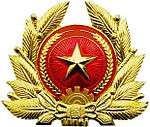
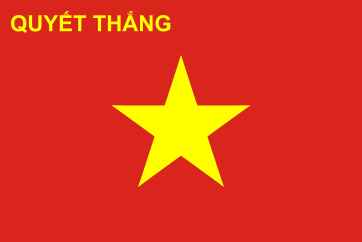
.svg.png)